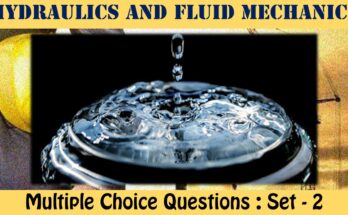MCQ Questions Civil Engineering Construction Planning and Management
The interviewer is almost as nervous as the candidate in most interviews. You might wonder if you look confident enough, if you will hire the right person, or if you are asking the right engineering interview questions. The last question is arguably the most crucial part to worry about when you’re interviewing candidates. Other topics on Civil Engineering Multiple Choice Questions can be accessed
MCQ Questions Civil Engineering Soil Mechanics and Foundation Engineering - Set - 5
Question 1:
Quick sand is a
A. type of sand
B. flow condition occurring in cohesive soils
C. flow condition occurring in cohesionless soils
D. flow condition occurring in both cohesive and cohesionless soils
Correct Answer – (A)
Question 2 :
The total and effective stresses at a depth of 5 m below the top level of water in a swimming pool are respectively
A. zero and zero
B. 0.5 kg/cm2 and zero
C. 0.5 kg/cm2 and 0.5 kg/cm2
D. 1.0 kg/cm2 and 0.5 kg/cm2
Correct Answer – (B)
Question 3 :
Effective stress is
A. the stress at particles contact
B. a physical parameter that can be measured
C. important because it is a function of engineering properties of soil
D. all of the above
Correct Answer – (C)
Question 4 :
The clay mineral with the largest swelling and shrinkage characteristics is
A. kaolinite
B. illite
C. montmorillonite
D. none of the above
Correct Answer – (C)
Question 5 :
Inorganic soils with low compressibility are represented by
A. MH
B. SL
C. ML
D. CH
Correct Answer – (C)
MCQ Questions Civil Engineering Soil Mechanics and Foundation Engineering
Question 6:
If the water table rises upto ground surface, then the
A. effective stress is reduced due to decrease in total stress only but pore water pressure does not change
B. effective stress is reduced due to increase in pore water pressure only but total stress does not change
C. total stress is reduced due to increase in pore water pressure only but effec-tive stress does not change
D. total stress is increased due to de-crease in pore water pressure but effective stress does not change
Correct Answer – (B)
Question 7:
Rise of water table above the ground surface causes
A. equal increase in pore water pressure and total stress
B. equal decrease in pore water pressure and total stress
C. increase in pore water pressure but decrease in total stress
D. decrease in pore water pressure but increase in total stress
Correct Answer – (A)
Question 8:
Dispersed type of soil structure is an arrangement comprising particles having
A. face to face or parallel orientation
B. edge to edge orientation
C. edge to face orientation
D. all of the above
Correct Answer – (A)
Question 9:
Sand particles are made of
A. rock minerals
B. kaolinite
C. illite
D. montmorillonite
Correct Answer – (A)
Question 10:
Highway Research Board (HRB. classification of soils is based on
A. particle size composition
B. plasticity characteristics
C. both particle size composition and plasticity characteristics
D. none of the above
Correct Answer – (C)
- NCERT Solutions Class 12 Mathematics RD Sharma Sets : Exercise 1.1
- NCERT Solutions Class 12 Mathematics RD Sharma Sets : Exercise 1.2
- NCERT Solutions Class 12 Mathematics RD Sharma Sets : Exercise 1.3
- NCERT Solutions Class 12 Mathematics RD Sharma Sets : Exercise 1.4
- NCERT Solutions Class 12 Mathematics RD Sharma Trigonometric Functions : Exercise – 5.1
- NCERT Solutions Class 12 Mathematics RD Sharma Trigonometric Functions : Exercise – 5.2
- NCERT Solutions Class 12 Mathematics RD Sharma Trigonometric Functions : Exercise – 5.3
- NCERT Solutions Class 12 Mathematics RD Sharma Quadratic Equations : Exercise – 14.1
- NCERT Solutions Class 12 Mathematics RD Sharma Quadratic Equations : Exercise – 14.2
- NCERT Solutions Class 12 Mathematics RD Sharma Linear Inequations : Exercise – 15.1
- NCERT Solutions Class 12 Mathematics RD Sharma Linear Inequations : Exercise – 15.2
- NCERT Solutions Class 12 Mathematics RD Sharma Linear Inequations : Exercise – 15.3
- NCERT Solutions Class 12 Mathematics RD Sharma Linear Inequations : Exercise – 15.4
- NCERT Solutions Class 12 Mathematics RD Sharma Linear Inequations : Exercise – 15.5
- NCERT Solutions Class 12 Mathematics RD Sharma Linear Inequations : Exercise – 15.6
Multiple Choice Questions for Competitive Exams
- Multiple Choice Questions Class 12 Chemistry The Solid State
Set -1 Set -2 Set -3 Set -4 Set -5 - MCQ Questions Class 12 Solutions With Answers
Set -1 Set -2 Set -3 Set -4 Set -5 - MCQ Questions Class 12 Electrochemistry With Answers
Set -1 Set -2 Set -3 Set -4 Set -5 - MCQ Questions Class 12 Chemical Kinetics With Answers
Set -1 Set -2 Set -3 Set -4 Set -5 - MCQ Questions Class 12 Surface Chemistry With Answers
Set -1 Set -2 Set -3 Set -4 Set -5 - MCQ Questions Class 12 General Principles and Processes of Isolation of Elements With Answers
Set -1 Set -2 Set -3 Set -4 Set -5




